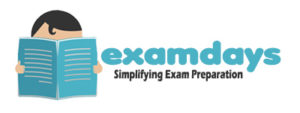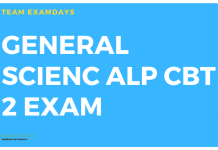
ALP CBT Engineering Drawing MCQ Quiz: RRB ALP CBT 2 have a topic of Engineering Drawing as a major subject MCQ Quiz which is helpful for ALP.RRB ALP CBT 2 Exam starts on 21 January onwards 2019. The weight of Engineering drawing in ALP CBT 2 is Good. you can download the Basic Engineering Drawing books PDF. You can also download the ALP Practise Papers PDF.
Engineering Drawing MCQ Quiz
Question 1: Which line type is thin and light?
A) Visible lines
B) Centerlines
C) Construction lines
D) All of the above
[su_spoiler title=”Answer” style=”fancy”]
Construction lines
[/su_spoiler]
Question 2:A French curve is used to draw
A) Circle
B) Ellipse
C) Smooth free form curve
D) Polygon
[su_spoiler title=”Answer” style=”fancy”]
Smooth free form curve
[/su_spoiler]
Question 3:Which tool can be used to draw a 90 degree angle?
A) 30/60 triangle
B) Protractor
C) Drafting machine
D) All of the above
[su_spoiler title=”Answer” style=”fancy”]
All of the above
[/su_spoiler]
Question 4:Which type of line is part of a dimension?
A) Break lines
B) Phantom lines
C) Extension lines
D) Cutting plane lines
[su_spoiler title=”Answer” style=”fancy”]
Extension lines
[/su_spoiler]
Question 5:Which type of line is particular to section drawings?
A) Break lines
B) Phantom lines
C) Extension lines
D) Cutting plane lines
[su_spoiler title=”Answer” style=”fancy”]
Cutting plane lines
[/su_spoiler]
Question 6:A drawing instrument set usually contains all of the following, except:
A) Bow compass
B) Scale
C) Dividers
D) Extra leads
[su_spoiler title=”Answer” style=”fancy”]
Extra leads
[/su_spoiler]
Question 7:Which line type is thick and black?
A) Visible lines
B) Center lines
C) Construction lines
D) All of the above
[su_spoiler title=”Answer” style=”fancy”]
Visible lines
[/su_spoiler]
Question 8:Which type of line has precedence over all other types of lines?
A) A hidden line
B) A center line
C) A visible line
D) None of the above
[su_spoiler title=”Answer” style=”fancy”]
A visible line
[/su_spoiler]
Question 9:Which angle cannot be made with either a 45 or 30/60 triangle or a combination of the two?
A) 90 B) 70 C) 30 D) 15
[su_spoiler title=”Answer” style=”fancy”]
70
[/su_spoiler]
Question 10:Which statement(s) is true about the precedence of lines?
A) A hidden line has precedence over a center line
B) A center line has precedence over a visible line
C) A visible line has precedence over a miter line
D) All of the above
[su_spoiler title=”Answer” style=”fancy”]
A hidden line has precedence over a center line
[/su_spoiler]
Question 11:When you want to make the letters of a line of text narrower, you would set its:
A) Aspect
B) Scale
C) Alignment
D) Font
[su_spoiler title=”Answer” style=”fancy”]
Aspect
[/su_spoiler]
Question 12:When you want to make sure that all of the text stays to the right of a given point on the drawing, you wound set its:
A) Aspect
B) Scale
C) Alignment
D) Font
[su_spoiler title=”Answer” style=”fancy”]
Alignment
[/su_spoiler]
Question 13:The primary unit of measurement for engineering drawings and design in the mechanical industries is the
A) Millimeter
B) Centimeter
C) Meter
D) Kilometer
[su_spoiler title=”Answer” style=”fancy”]
Millimetre
[/su_spoiler]
Question 14: Which set of lead grades has a grade out of sequence?
A) H, HB, B, 3B
B) 7B, H, F, 3H
C) 6B, B, H, 4H
D) 9H, HB, B, 2B
[su_spoiler title=”Answer” style=”fancy”]
7B, H, F, 3H
[/su_spoiler]
Question 15 The projection showing the front in the true shape and size is
- (a) isometric
- (b) perspective
- (c) oblique
- (d) axonometric
[su_spoiler title=”Answer” style=”fancy”]
blique
[/su_spoiler]
Question 16 An axonometric projection in which three perpendicular edges of the object make different angles with the plane of projection is called
- (a) isometric projection
- (b) diametric projection
- (c) trimetric projection
- (d) oblique projection
[su_spoiler title=”Answer” style=”fancy”]
trimetric projection
[/su_spoiler]
Question 17 What type of line has precedence over all other types of lines?
- (a) hidden line
- (b) centre line
- (c) visible line
- (d) none of the above
[su_spoiler title=”Answer” style=”fancy”]
visible line
[/su_spoiler]
Question 18 Inclined planes in a three-view drawing will appear as
- (a) two surfaces and one edge
- (b) one surface and two edges
- (c) three edges
- (d) foreshortened in each view
[su_spoiler title=”Answer” style=”fancy”]
foreshortened in each view
[/su_spoiler]
Question 19 When a surface of an object is inclined to a plane of projection, it will appear in the view
- (a) foreshortened
- (b) in true size and shape
- (c) as a line
- (d) as a point
[su_spoiler title=”Answer” style=”fancy”]
foreshortened
[/su_spoiler]
Question 20 The top view of an object should typically be drawn
- (a) to the right of the front view
- (b) directly below the front view
- (c) anywhere on the same page
- (d) on a separate piece of paper
[su_spoiler title=”Answer” style=”fancy”]
directly below the front view
[/su_spoiler]
Question 21 This type of projection is when projectors are parallel to each other, but are at an angle other than 90 degrees to the plane of projection:
- (a) perspective
- (b) oblique
- (c) aesthetic
- (d) angular
[su_spoiler title=”Answer” style=”fancy”]
oblique
[/su_spoiler]
Question 22 This is how axonometric, oblique, and perspective sketches show objects
- (a) Orthographically
- (b) Pictoriall
- y(c) Obliquely
- (d) Parallel
[su_spoiler title=”Answer” style=”fancy”]
Pictorial
[/su_spoiler]
Question 23 Which is not a principal view?
- (a) front
- (b) bottom
- (c) auxiliary
- (d) left side
[su_spoiler title=”Answer” style=”fancy”]
Auxiliary
[/su_spoiler]
Question 24 The primary unit of measurement for engineering drawings and design in the mechanical industries is the
- (a) millimeter
- (b) centimeter
- (c) meter
- (d) kilometer
[su_spoiler title=”Answer” style=”fancy”]
millimeter
[/su_spoiler]
Question 25 This type of section is limited by a break line
- (a) removed section
- (b) revolved section
- (c) broken-out section
- (d) half section
[su_spoiler title=”Answer” style=”fancy”]
broken-out section
[/su_spoiler]
Question 26 This type of solid has two bases that are parallel equal polygons:
- (a) pyramid
- (b) prism
- (c) cone
- (d) torus
[su_spoiler title=”Answer” style=”fancy”]
prism
[/su_spoiler]
Question 27 The solid having a polygon for a base and triangular lateral faces intersecting at a vertex is
- (a)pyramid
- (b) prism
- (c) cone
- (d) torus
[su_spoiler title=”Answer” style=”fancy”]
pyramid
[/su_spoiler]
Question 28 This is formed where three or more surfaces intersect:
- (a) oblique
- (b) line
- (c) edge
- (d) vertex
[su_spoiler title=”Answer” style=”fancy”]
line
[/su_spoiler]
Question 29 These types of projectors converge at a vanishing point
- (a) perspective
- (b) parallel
- (c) orthographic
- (d) oblique
[su_spoiler title=”Answer” style=”fancy”]
perspective
[/su_spoiler]
Question 30 In oblique sketches, the most commonly used angles for receding lines are
- (a) 15 or 60 degrees
- (b) 15 or 75 degrees
- (c) 45 or 60 degrees
- (d) 45 or 75 degrees
[su_spoiler title=”Answer” style=”fancy”]
45 or 60 degrees
[/su_spoiler]
Question 31 The top and right side views have common dimensions of
- (a) height and width
- (b) width and depth
- (c) height
- (d) depth
[su_spoiler title=”Answer” style=”fancy”]
depth
[/su_spoiler]
Question 32 Objects that are symmetric can be shown effectively using this type of section
- (a) quarter section
- (b) half section
- (c) full section
- (d) symmetric section
[su_spoiler title=”Answer” style=”fancy”]
hal section
[/su_spoiler]
Question 33 In this type of section, one-quarter of the object is removed
- (a) revolved section
- (b) removed section
- (c) quarter section
- (d) half section
[su_spoiler title=”Answer” style=”fancy”]
half section
[/su_spoiler]
Question 34 This type of section is not in direct projection from the view containing the cutting plane
- (a) revolved section
- (b) removed section
- (c) broken-out section
- (d) full section
[su_spoiler title=”Answer” style=”fancy”]
revolved section
[/su_spoiler]
Question 35 With the combination of T-square, the following angles can be drawn except
a. 15°
b. 25°
c. 45°
d. 105°
[su_spoiler title=”Answer” style=”fancy”]
25°
[/su_spoiler]
Question 36 Which of the following compass is used to draw very large circles?
a. Beam
b. Large
c. Bow
d. Drop
[su_spoiler title=”Answer” style=”fancy”]
Beam
[/su_spoiler]
Question 37 The mini drafter serves the purpose of everything except
a. Scales
b. Set square
c. Protractor
d. Compass
[su_spoiler title=”Answer” style=”fancy”]
Compass
[/su_spoiler]
Question 38 Which of the following is not used to fix drawing sheet on the board?
a. Drawing pins
b. Adhesive tapes
c. Clips
d. Thread
[su_spoiler title=”Answer” style=”fancy”]
Thread
[/su_spoiler]
Question 39 Which of the following compass is used lo draw small size circles?
a. Beam
b. Large
c. Bow
d. Drop
[su_spoiler title=”Answer” style=”fancy”]
Drop
[/su_spoiler]
Question 40 The designation of sheet of size 594 x 841 is
a. A0
b. A1
c. A2
d. A3
[su_spoiler title=”Answer” style=”fancy”]
A1
[/su_spoiler]
Question 41 Which of the following is softest pencil?
a. 2B
b. 1B
c. HB
d. H
[su_spoiler title=”Answer” style=”fancy”]
2B
[/su_spoiler]
Question 42 Which of the following is the lightest
pencil?
a. 2B
b. 1B
c. HB
d. H
[su_spoiler title=”Answer” style=”fancy”]
H
[/su_spoiler]
Question 43 During operation, the two arms of the drafter remain at
a. 45°
b. 90°
c. 180°
d. 270°
[su_spoiler title=”Answer” style=”fancy”]
90°
[/su_spoiler]
Question 44 Which of the following is not a pictorial drawing?
A) isometric
B) multiview
C) perspective
D) axonometric
[su_spoiler title=”Answer” style=”fancy”]
multiview
[/su_spoiler]
Question 45 Which of the following projection methods does not use projectors perpendicular to the
projection plane?
A) isometric
B) orthographic
C) oblique
D) axonometric
[su_spoiler title=”Answer” style=”fancy”]
oblique
[/su_spoiler]
Question 46 If a client of yours is having difficulty visualizing a design, what type of drawing would be the easiest to understand?
A) axonometric
B) three-view orthographic
C) one-view orthographic
D) bimetric
[su_spoiler title=”Answer” style=”fancy”]
axonometric
[/su_spoiler]
Q uestion 47 In an isometric sketch of a cube:
A) the frontal face appears in its true shape
B) the receding axes are at 45 degrees to
the horizontal
C) all faces are equally distorted
D) only the depth distances must be
reduced
[su_spoiler title=”Answer” style=”fancy”]
all faces are equally distorted
[/su_spoiler]
Question 48 A circle will appear on an isometric
drawing as a(n) __________ .
A) ellipse
B) cycloid
C) circle
D) parabola
[su_spoiler title=”Answer” style=”fancy”]
ellipse
[/su_spoiler]
Question 49 . An axonometric drawing which has allthree axes divided by equal angles is:
A) dimetric
B) trimetric
C) orthographic
D) isometric
[su_spoiler title=”Answer” style=”fancy”]
isometric
[/su_spoiler]
Question 50 In a trimetric drawing, the relationship ofthe angle between axes to each other is:
A) three are equal
B) two are equal
C) three are unequal
D) none of the above
[su_spoiler title=”Answer” style=”fancy”]
none of the above
[/su_spoiler]
Question 51. An axonometric drawing which has twoaxes divided by equal angles is:
A) dimetric
B) trimetric
C) orthographic
D) isometric
[su_spoiler title=”Answer” style=”fancy”]
dimetric
[/su_spoiler]
Question 52. In isometric drawings:
A) Two axes are perpendicular
B) True measurements can be made only
along or parallel to the isometric axes
C) All faces are unequally distorted
D) None of the above
[su_spoiler title=”Answer” style=”fancy”]
True measurements can be made only
[/su_spoiler]
Question 53 In an axonometric drawing, the projection rays are drawn _________ to each other and _______ to the plane of projection.
A) parallel…..oblique
B) oblique…..parallel
C) parallel…..perpendicular
D) parallel….parallel
[su_spoiler title=”Answer” style=”fancy”]
parallel…..perpendicular
[/su_spoiler]
NEXT QUIZ







